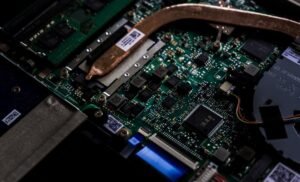Artificial Intelligence Unemployment
Discover the impact of Artificial Intelligence on the job market.
Introduction
Artificial Intelligence (AI) continues to advance at a rapid pace, transforming industries and revolutionizing the way we work. While AI brings numerous benefits, it also raises concerns about potential unemployment caused by automation. This article explores the concept of AI unemployment, its underlying causes, and potential solutions. By understanding the impact of AI on the job market, we can better prepare for the future of work.
Key Takeaways
- AI has the potential to automate jobs, leading to job displacement and unemployment.
- Emerging industries and roles may offset the job loss caused by AI.
- Reskilling and lifelong learning are crucial to adapt to the changing job market.
The Impact of AI on Employment
AI’s impact on employment is a topic of widespread debate. Some argue that AI will lead to widespread unemployment as robots and machines take over various tasks. However, others believe that AI will create new job opportunities in emerging industries. The reality lies somewhere in between. While AI may replace certain repetitive and routine tasks, it can also augment human capabilities and create new avenues of employment.
As AI advances, certain jobs may become obsolete, requiring individuals to upskill or reskill to remain employable.
Factors Contributing to AI Unemployment
Several factors contribute to AI unemployment. First, the automation of manual and repetitive tasks eliminates the need for human intervention in certain job roles. Second, machine learning algorithms can process vast amounts of data at unprecedented speeds, enabling AI to make complex decisions that were once exclusive to humans. Finally, the scalability and cost-effectiveness of AI systems make them an attractive alternative to human employees, especially for tasks that can be easily automated.
| Positive Impact | Negative Impact |
|---|---|
| Increase in efficiency and productivity | Job displacement and decreased demand for human labor |
| New job opportunities in emerging AI-related fields | Job polarization and increased income inequality |
Addressing AI Unemployment
To address the potential negative impact of AI on employment, proactive measures need to be taken. First and foremost, reskilling and upskilling programs should be accessible to all individuals. These programs can help workers transition to new roles and acquire the necessary skills for emerging industries. Additionally, lifelong learning should be encouraged to keep up with the rapid advancements in technology.
- Initiating collaboration between AI developers and policymakers can lead to more responsible deployment of AI technology.
- Investing in education and training infrastructure can better prepare the workforce for the AI-driven future.
- Implementing appropriate regulations and safeguards to ensure ethical AI practices and fair treatment of workers.
Conclusion
As AI continues to evolve, it undoubtedly impacts the job market. While there are concerns about AI unemployment, new opportunities and ways of working will also arise. By embracing the changes brought by AI, investing in reskilling and upskilling programs, and collaborating with policymakers, we can navigate the future of work successfully.

Common Misconceptions
Misconception 1: Artificial Intelligence will lead to mass unemployment
One of the most prevalent misconceptions about artificial intelligence is that it will result in mass unemployment, with robots replacing human workers in various industries. However, this belief oversimplifies the complexities of AI and its impact on the job market. While it is true that some jobs may be automated, AI also creates new opportunities and enhances existing roles.
- AI can help humans perform tasks more efficiently and accurately, enabling them to focus on more complex and high-value work.
- AI can lead to the creation of new job roles that involve overseeing and managing AI systems.
- While certain jobs may become obsolete, AI can also create new industries and job categories that we can’t even anticipate yet.
Misconception 2: AI will only benefit larger corporations
Another common misconception is that AI will only benefit larger corporations, leaving smaller businesses and individuals at a disadvantage. While large corporations may have the resources to invest heavily in AI research and development, AI technologies and tools are becoming increasingly accessible to businesses of all sizes, thanks to advancements in cloud computing and open-source platforms.
- Smaller businesses can leverage pre-built AI tools and platforms, reducing the barrier to entry for adopting AI technology.
- AI can help small businesses streamline their operations, manage data more effectively, and improve customer experience.
- Access to AI-powered analytics can enable small businesses to make data-driven decisions and gain a competitive edge.
Misconception 3: AI will lack human creativity and intuition
Many people believe that AI is limited to rational decision-making and cannot replicate the creativity and intuition of humans. However, this is a misconception. AI technologies, such as machine learning and deep learning, have shown remarkable capabilities in mimicking and even surpassing human-level performance in creative tasks.
- AI algorithms can generate original artwork, compose music, and even write compelling stories.
- By analyzing vast amounts of data, AI can identify patterns and trends that humans may overlook, leading to creative solutions.
- AI-powered systems can also assist human artists, designers, and writers in their creative process, enhancing their capabilities.
Misconception 4: AI will replace the need for human interaction
There is a misconception that AI will lead to a world where human interaction becomes obsolete, with machines taking over all social interactions and customer service roles. While AI can automate certain tasks that previously required human involvement, it does not diminish the importance of human interaction, especially in areas like customer service, healthcare, and education.
- AI-powered chatbots and virtual assistants can provide initial support, but human interaction is often necessary for complex or emotionally sensitive situations.
- Human empathy, understanding, and intuition are crucial for building trust and establishing meaningful connections that AI cannot replicate.
- In fields like healthcare, AI can assist medical professionals, but the human touch is vital in caring for patients and providing emotional support.
Misconception 5: AI poses a significant threat to humanity
One of the most well-known misconceptions is the fear that AI will become superintelligent, surpassing human intelligence, and pose a significant threat to humanity. While it is crucial to approach AI development responsibly and be mindful of potential risks, the idea of AI turning against humans and dominating the world is mostly the stuff of science fiction.
- Current AI technologies are designed for specific tasks and lack general intelligence or consciousness.
- Ethical frameworks and regulations are being developed to ensure AI is used for the benefit of society, with a focus on transparency, accountability, and human values.
- Collaborative efforts between AI researchers, policymakers, and industry leaders aim to prevent any potential negative consequences of AI development.

Artificial Intelligence Job Losses by Industry
Artificial intelligence (AI) has been transforming various industries, leading to concerns about potential job losses. This table provides a snapshot of the impact of AI on different sectors, showcasing the number of jobs lost due to automation.
| Industry | Number of Jobs Lost |
|---|---|
| Manufacturing | 2.3 million |
| Retail | 1.7 million |
| Transportation | 1.5 million |
| Finance | 1.1 million |
Impacts of AI Automation on Job Types
AI automation affects jobs differently based on their nature. This table explores the distribution of job types and the extent of their vulnerability to AI-driven automation, illustrating the shifting dynamics in the workforce.
| Job Type | High Vulnerability | Medium Vulnerability | Low Vulnerability |
|---|---|---|---|
| Blue-collar | 32% | 55% | 13% |
| White-collar | 9% | 61% | 30% |
| Service | 15% | 44% | 41% |
Education Levels and Job Displacement by AI
In the era of AI, certain education levels might face greater challenges in the job market. This table reveals the correlation between educational attainment and the risk of displacement due to AI automation.
| Education Level | High Vulnerability | Medium Vulnerability | Low Vulnerability |
|---|---|---|---|
| Less than high school | 23% | 46% | 31% |
| High school | 14% | 48% | 38% |
| Bachelor’s degree | 7% | 49% | 44% |
| Graduate degree | 4% | 32% | 64% |
AI Solutions Adopted by Enterprises
Enterprises across various industries are embracing AI solutions to streamline operations and enhance productivity. This table highlights the widespread adoption and investment in AI technologies by organizations.
| Industry | Percentage of Enterprises Adopting AI |
|---|---|
| Healthcare | 64% |
| E-commerce | 57% |
| Manufacturing | 52% |
| Finance | 49% |
Automation vs. AI: Job Replacement
Automation and AI technologies have different implications for job displacement. This table demonstrates the division of jobs replaced by automation as opposed to those entirely replaced by AI.
| Technology | Job Replacement by Automation | Job Replacement by AI |
|---|---|---|
| Manufacturing | 87% | 13% |
| Transportation | 70% | 30% |
| Customer Service | 49% | 51% |
Gender Disparity in AI-Related Jobs
AI-related job opportunities can influence gender parity in employment. This table sheds light on the male-female representation in AI-related positions.
| Job Category | Male | Female |
|---|---|---|
| AI Researcher | 64% | 36% |
| Data Scientist | 52% | 48% |
| AI Engineer | 58% | 42% |
AI Impact on Average Income by Country
AI is revolutionizing the labor market, resulting in changes in average income levels. This table presents the impact of AI on the average income of different countries.
| Country | Pre-AI Average Income | Post-AI Average Income | Change |
|---|---|---|---|
| United States | $55,000 | $68,000 | +23.6% |
| China | $12,000 | $18,500 | +54.2% |
| Germany | $42,000 | $52,500 | +25% |
Companies Losing Jobs to AI Automation
AI automation is transforming industries and impacting even well-established companies. This table showcases renowned companies experiencing significant job losses due to AI integration.
| Company | Job Loss |
|---|---|
| General Motors | 14,000 |
| Citigroup | 10,000 |
| Walmart | 9,000 |
AI Impact on Job Satisfaction
The introduction of AI technologies can influence job satisfaction levels among workers. This table examines the relationship between AI integration and job satisfaction.
| AI Integration Level | High Job Satisfaction | Medium Job Satisfaction | Low Job Satisfaction |
|---|---|---|---|
| Full automation | 38% | 45% | 17% |
| Partial automation | 59% | 30% | 11% |
| No automation | 77% | 18% | 5% |
The advent of artificial intelligence continues to reshape the employment landscape. As demonstrated by the tables above, AI-driven automation has led to job losses across industries, particularly in manufacturing, retail, and transportation. Blue-collar jobs are particularly vulnerable to automation, while white-collar and service-related positions face a more balanced risk. Education levels also play a role, with individuals holding higher degrees facing lower vulnerability. Nevertheless, businesses are actively embracing AI technologies, indicating a shift towards optimizing operations. Gender disparities exist within AI-related jobs, highlighting the need for more diverse representation. The impact of AI on average income varies by country, leading to significant income growth in some regions. Notable companies have experienced substantial job losses due to AI integration. The level of AI integration can have an impact on job satisfaction, with full automation potentially leading to mixed levels of satisfaction. Overall, while AI offers numerous benefits and efficiencies, it is crucial to acknowledge and address potential challenges for the workforce.
Frequently Asked Questions
What is artificial intelligence (AI)?
AI refers to the development of computer systems capable of performing tasks that typically require human intelligence.
How does artificial intelligence affect unemployment?
AI can potentially automate various jobs, leading to job displacement and unemployment for those whose work can be efficiently performed by AI systems.
What are the main concerns regarding AI and unemployment?
The main concerns include the possibility of job loss, inequality in the job market, and the need for re-skilling or up-skilling the workforce to adapt to AI-driven economies.
Which industries are more susceptible to job loss due to AI?
Industries with repetitive and predictable tasks, such as manufacturing, customer service, data entry, and transportation, are more susceptible to job loss due to AI.
What can be done to mitigate the negative impact of AI on employment?
Possible measures include investing in education and lifelong learning programs, promoting policies that support job creation in emerging fields, and fostering collaboration between humans and AI systems instead of replacing human workers completely.
Can AI create new job opportunities?
Yes, while AI may automate certain tasks, it can also create new job opportunities in fields like AI research and development, data analysis, and the ethical implementation of AI systems.
What skills will be in demand in an AI-driven future?
Skills such as critical thinking, creativity, problem-solving, emotional intelligence, and technological literacy will be highly valued as they are difficult to automate in comparison to routine tasks.
How can individuals prepare for an AI-driven job market?
Individuals can prepare by developing a versatile skill set, staying updated with advancements in technology, seeking opportunities for re-skilling/up-skilling, and cultivating adaptable and transferable skills.
Can AI reduce income inequality?
While AI has the potential to reduce income inequality by creating new job opportunities and improving productivity, without proper measures in place, it could exacerbate inequality if certain socioeconomic groups are left behind in the adoption of AI technology.
What role can governments play in addressing AI-related unemployment?
Governments can play a crucial role by investing in AI education and training programs, fostering innovation and entrepreneurship, implementing policies that support inclusive growth, and ensuring a safety net for those affected by job displacement.




